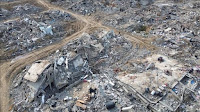Iran informed the US about the attack 12 hours before it was
to happen, according to information previously disclosed by the Tehran Times.
The official American response was swift and predictable - both Washington and
Doha downplayed the incident, claiming there were no casualties or significant
damage. However, reality soon overrode the narrative. Satellite images
published days later confirmed the destruction of a geodesic dome that housed
critical communication systems of the US Central Command.
Far from being anecdotal, this episode marks a strategic
turning point. Iran has shown it can strike critical infrastructure under
American protection, redrawing the contours of deterrence in the Persian Gulf.
The missile ceases to be merely a weapon of war; it becomes a tool of
sovereignty and strategic assertion.
Between
official denial and satellite evidence
The US version was clear and firm from the outset “No
casualties, no damage,” repeated Pentagon spokespeople. But satellite evidence,
analyzed by international media and independent agencies, told a different
story.
Images taken between June 23 and 25 showed the disappearance
of a US$15 million communications dome, debris, and collateral damage to
surrounding structures. Although the base remained operational, the loss of a
key component for electronic warfare cast doubt on the effectiveness of US missile
defenses—and on the credibility of the official account.
Washington’s refusal to acknowledge the strike follows a
dual logic - maintaining control over the media narrative and avoiding the
perception of vulnerability before an actor—Iran—that, despite sanctions and
isolation, has reached a notable level of technological sophistication.
Al
Udeid: A symbol of hegemony in question
Located about 30 kilometers from Doha, Al Udeid is more than
just a military base. It serves as the forward headquarters of CENTCOM and is
the nerve center for coordinating operations in Iraq, Syria, and Afghanistan.
Its symbolism goes beyond the military - it is the cornerstone of the security
architecture the United States has built in the region since the First Persian
Gulf War.
The fact that Iran managed to strike such a site—and that US
forces reportedly evacuated aircraft and sensitive personnel beforehand—does
not diminish the significance of the attack. On the contrary, it indicates that
Tehran sent a precise warning and that Washington took it seriously. Deterrence,
long monopolized by the US and Israel, is no longer a one-way street.
The
missile as national strategy: Evolution and autonomy
The strike on Al Udeid was not an isolated act but the
result of a deliberate evolution. For over two decades, Iran has systematically
invested in ballistic missile development as an asymmetric response to the air
and nuclear superiority of its adversaries. Faced with Western restrictions,
Tehran adopted a doctrine of defensive self-sufficiency based on three pillars:
Diversification: Short, medium, and long range missiles
like Shahab-3, Ghadr, Qiam, and Sejjil, capable of reaching Israel, US bases,
and parts of southern Europe.
Mobility: Mobile launch systems that are hard to detect
and neutralize.
Precision: Advanced guidance systems that have reduced the
margin of error to levels that even Western analysts now acknowledge.
Unlike other regional missile programs, Iran’s development
is overwhelmingly domestic. This technical and logistical autonomy has allowed
the country to bypass embargoes and threats, turning the missile into the
backbone of its defense doctrine.
Following Israel’s offensive against nuclear, military, and
civilian sites inside Iran, Tehran responded with a large-scale launch of over
a hundred ballistic missiles and suicide drones targeting Israeli military
positions. For the first time, Iran’s ballistic arsenal was used en masse in open
conflict.
Despite the Iron Dome and other Israeli defenses, several
missiles penetrated and struck Tel Aviv, Haifa, and military bases. The missile
attacks not only caused physical damage but also had a strategic impact:
saturating defenses, prompting emergency deployments, and creating
unprecedented internal pressure on Israeli authorities.
The Al Udeid strike was the culmination of a graduated
strategy - to hit Israel, neutralize its offensive capacity, and send a direct
message to the United States. The ceasefire that followed days later cannot be
understood without factoring in the missile component as a deterrent force.
Sovereignty
and independence: The Iranian perspective
Since the 1979 Islamic Revolution, Iran’s foreign and
defense policy has been rooted in the principle of non-negotiable sovereignty.
In a hostile environment—surrounded by foreign bases and under sanctions—the
development of ballistic missiles has not been framed as a belligerent impulse,
but as a survival strategy.
Tehran maintains that its only guarantee in the face of
threats like the US “maximum pressure” campaign or Israeli targeted strikes is
its ability to respond. Effective deterrence, it argues, is only possible when
there is certainty that any aggression will come at a high cost.
The attack on Al Udeid follows this logic - it was
calibrated, precise, and deliberately non-lethal. Its aim was not to trigger a
regional war but to underscore that Iran has both the capacity—and the
resolve—to defend its vital interests. The missile, in this vision, is not a
threat; it is a political argument.






